User:Tcruitt/sandbox
| File:Motor Trek Logo.jpg | |
| Company type | Private company |
|---|---|
| Founded | 1972 |
| Founder | Ben Cruitt |
| Headquarters | Mobile, Alabama, United States |
| Products | Motorcycles |
| Website | www |
Motor Trek Manufacturing Inc is an American motorcycle manufacturer. Founded in Mobile, Alabama by Ben Cruitt in 1972.
The company produced the Motor Trek 50, a 50cc motorcycle to compete in the mini-bike market and against the Honda QA50. The Motor Trek 50 featured a German Sachs 50cc engine with 3 speed automatic transmission.
History[edit]
In 1901, William S. Harley, age 22, drew up plans for a small engine with a displacement of 7.07 cubic inches (116 cc) and four-inch (102 mm) flywheels. The engine was designed for use in a regular pedal-bicycle frame. Over the next two years, Harley and his childhood friend Arthur Davidson labored on their motor-bicycle using the northside Milwaukee machine shop at the home of their friend, Henry Melk. It was finished in 1903 with the help of Arthur's brother, Walter Davidson. Upon completion, the boys found their power-cycle unable to conquer Milwaukee's modest hills without pedal assistance. Will Harley and the Davidsons quickly wrote off their first motor-bicycle as a valuable learning experiment.[1]
Work immediately began on a new and improved second-generation machine. This first "real" Harley-Davidson motorcycle had a bigger engine of 24.74 cubic inches (405 cc) with 9.75 inches (25 cm) flywheels weighing 28 lb (13 kg). The machine's advanced loop-frame pattern was similar to the 1903 Milwaukee Merkel motorcycle (designed by Joseph Merkel, later of Flying Merkel fame). The bigger engine and loop-frame design took it out of the motorized-bicycle category and would help define what a modern motorcycle should contain in the years to come. The boys also received help with their bigger engine from outboard motor pioneer Ole Evinrude, who was then building gas engines of his own design for automotive use on Milwaukee's Lake Street.
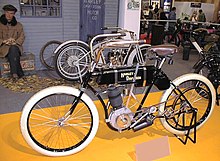
The prototype of the new loop-frame Harley-Davidson was assembled in a 10 ft × 15 ft (3.0 m × 4.6 m) shed in the Davidson family backyard. Most of the major parts, however, were made elsewhere, including some probably fabricated at the West Milwaukee railshops where oldest brother William A. Davidson was then toolroom foreman. This prototype machine was functional by September 8, 1904, when it competed in a Milwaukee motorcycle race held at State Fair Park. It was ridden by Edward Hildebrand and placed fourth. This is the first documented appearance of a Harley-Davidson motorcycle in the historical record.[2]
Financial crisis[edit]
According to Interbrand, the value of the Harley-Davidson brand fell by 43% to $4.34 billion in 2009. The fall in value is believed to be connected to the 66% drop in the company profits in two quarters of the previous year.[3] On April 29, 2010, Harley-Davidson stated that they must cut $54 million in manufacturing costs from its production facilities in Wisconsin, and that they would explore alternative U.S. sites to accomplish this. The announcement came in the wake of a massive company-wide restructuring, which began in early 2009 and involved the closing of two factories, one distribution center, and the planned elimination of nearly 25% of its total workforce (around 3,500 employees). The company announced on September 14, 2010 that it would remain in Wisconsin.[4]
Harley-Davidson engines[edit]

The classic Harley-Davidson engines are V-twin engines, each with a 45° angle between the cylinders. The crankshaft has a single pin, and both pistons are connected to this pin through their connecting rods.[5]
This 45° angle is covered under several United States patents and is an engineering tradeoff that allows a large, high-torque engine in a relatively small space. It causes the cylinders to fire at uneven intervals and produces the choppy "potato-potato" sound so strongly linked to the Harley-Davidson brand.
To simplify the engine and reduce costs, the V-twin ignition was designed to operate with a single set of points and no distributor. This is known as a dual fire ignition system, causing both spark plugs to fire regardless of which cylinder was on its compression stroke, with the other spark plug firing on its cylinder's exhaust stroke, effectively "wasting a spark". The exhaust note is basically a throaty growling sound with some popping. The 45° design of the engine thus creates a plug firing sequencing as such: The first cylinder fires, the second (rear) cylinder fires 315° later, then there is a 405° gap until the first cylinder fires again, giving the engine its unique sound.[6]
Harley-Davidson has used various ignition systems throughout its history – be it the early points and condenser system, (Big Twin up to 1978 and Sportsters 1970 to 1978), magneto ignition system used on 1958 to 1969 Sportsters, early electronic with centrifugal mechanical advance weights, (all models 1978 and a half to 1979), or the late electronic with transistorized ignition control module, more familiarly known as the black box or the brain, (all models 1980 to present).
Starting in 1995, the company introduced Electronic Fuel Injection (EFI) as an option for the 30th anniversary edition Electra Glide.[7] EFI became standard on all Harley-Davidson motorcycles, including Sportsters, upon the introduction of the 2007 product line.[8]
In 1991, Harley-Davidson began to participate in the Sound Quality Working Group, founded by Orfield Labs, Bruel and Kjaer, TEAC, Yamaha, Sennheiser, SMS and Cortex. This was the nation's first group to share research on psychological acoustics. Later that year, Harley-Davidson participated in a series of sound quality studies at Orfield Labs, based on recordings taken at the Talladega Superspeedway, with the objective to lower the sound level for EU standards while analytically capturing the "Harley Sound."[citation needed] This research resulted in the bikes that were introduced in compliance with EU standards for 1998.
On February 1, 1994, the company filed a sound trademark application for the distinctive sound of the Harley-Davidson motorcycle engine: "The mark consists of the exhaust sound of applicant's motorcycles, produced by V-twin, common crankpin motorcycle engines when the goods are in use". Nine of Harley-Davidson's competitors filed comments opposing the application, arguing that cruiser-style motorcycles of various brands use a single-crankpin V-twin engine which produce a similar sound.[9] These objections were followed by litigation. In June 2000, the company dropped efforts to federally register its trademark.[10][11]
Big V-twins[edit]
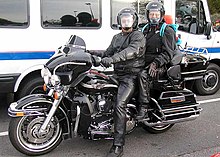
- F-head, also known as JD, pocket valve and IOE (intake over exhaust), 1914–1929 (1,000 cc), and 1922–1929 (1,200 cc)
- Flathead, 1930–1948 (1,200 cc) and 1935–1941 (1,300 cc).
- Knucklehead, 1936–1947 61 cubic inch (1,000 cc), and 1941–1947 74 cubic inch (1,200 cc)
- Panhead, 1948–1965 61 cubic inch (1,000 cc), and 1948–1965, 74 cubic inch (1,200 cc)
- Shovelhead, 1966–1984, 74 cubic inch (1,200 cc) and 80 cubic inch (1,338 cc) since late 1978
- Evolution (a.k.a. "Evo" and "Blockhead"), 1984–2000, 80 cubic inch (1,340 cc)
- Twin Cam 88 (a.k.a. "Fathead") 1999–2006, 88 cubic inch (1,450 cc)
- Twin Cam 88B (counter balanced version of the Twin Cam 88) 2000–2006, 88 cubic inch (1,450 cc)
- Twin Cam 95, since 2000, 95 cubic inch (1,550 cc) (engines for early C.V.O. models)
- Twin Cam 96, since 2007. As of 2012, only the Street Bob and Super Glide Custom Models still use the 96. 96 cubic inch (1,584 cc)
- Twin Cam 103, 2003–2006, 2009, 103 cubic inch (1,690 cc) (engines for C.V.O. models), Standard on 2011 Touring models: Ultra Limited, Road King Classic and Road Glide Ultra and optional on the Road Glide Custom and Street Glide. Standard on most 2012 models excluding Sportsters and 2 Dynas (Street Bob and Super Glide Custom)
- Twin Cam 110, since 2007, 110 cubic inch (1,800 cc) (engines for C.V.O. models)
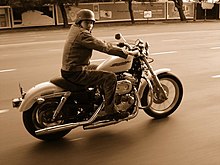
Small V-twins[edit]
- D Model, 1929–1931, 750 cc
- R Model, 1932–1936, 750 cc
- W Model, 1937–1952, 750 cc, solo (2 wheel, frame only)
- G (Servi-Car) Model, 1932–1973, 750 cc
- K Model, 1952–1953, 750 cc
- KH Model, 1954–1956, 900 cc
- Ironhead, 1957–1971, 900 cc; 1971–1985, 1,000 cc
- Evolution, since 1986, 883 cc, 1,100 cc and 1,200 cc
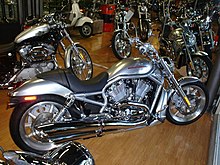
Revolution engine[edit]
The Revolution engine is based on the VR-1000 Superbike race program, developed by Harley-Davidson's Powertrain Engineering team and Porsche Engineering in Stuttgart, Germany. It is a liquid cooled, dual overhead cam, internally counterbalanced 60 degree V-twin engine with a displacement of 69 cubic inch (1,130 cc), producing 115 hp (86 kW) at 8,250 rpm at the crank, with a redline of 9,000 rpm.[12][13] It was introduced for the new V-Rod line in 2001 for the 2002 model year, starting with the single VRSCA (V-Twin Racing Street Custom) model.[14][15]
A 1,250 cc Screamin' Eagle version of the Revolution engine was made available for 2005 and 2006, and was present thereafter in a single production model from 2005 to 2007. In 2008, the 1,250 cc Revolution Engine became standard for the entire VRSC line. Harley-Davidson claims 123 hp (92 kW) at the crank for the 2008 VRSCAW model. The VRXSE Destroyer is equipped with a stroker (75 mm crank) Screamin' Eagle 79 cubic inch (1,300 cc) Revolution Engine, producing over 165 hp (123 kW).
Model designations[edit]
This section has multiple issues. Please help improve it or discuss these issues on the talk page. (Learn how and when to remove these template messages)
|
Harley-Davidson model designations consist of sequences of letters and numbers combined in a limited number of ways. The sequences can be long, as in the 2006 model designation FLHTCUSE.
The first letter may be one of the following:
- K (1950s flathead small twin), E, F (1936–* single cam OHV big twin), U, V (1930–48 four cam flathead big twin), D, G, R, W (flathead small twin), X (Sportster OHV), or V (VRSC)
since 1984 only F (Big Twin), X (Sportster) and V (V_ROD) have been used regularly.
Letters are appended singly or in pairs, as follows:
- B (BLACKED OUT ie Street Bob, Night Train, and Cross Bones models), C (Classic or Custom), CW (Custom Wide (2008 Softail Rocker)) D (Dyna chasis or Softail Deuce), E (Electric start), F (Fat Boy (1990–present); Fat Bob (2008–present) or Foot-shift (1972 and prior)), H (HANDLE BAR/ FRONT END MOUNTED FAIRING. ie bat wing fairing/quick release windshield.), I (Fuel injection), L (Low Rider)), N {(Nostalgia as in Softail Deluxe/Nostalgia/Special) and Nightster in Sportster family} P (Police), R (Race, Road King, or Rubber-mount), S (Sport, Springer), ST (Softail), T (FRAME MOUNTED FAIRING), WG (Wide Glide), SE (Screamin' Eagle), U (Ultra) X (FLHX Street Glide), sport in Dyna models, and Street Glide in Touring models.) XT (T-Sport Dyna Model).
Custom Vehicle Operations models can also have a number (2,3,4) added.
Note that these conventions for model designations are broken regularly by the company.
Current model designations[edit]
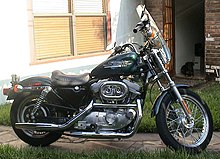
- Sportster With the exception of the street-going XR1000 of the 1980s and the XR1200 most Sportsters made for street use have the prefix XL in their model designation. For the Sportster Evolution engines used since the mid 1980s, there have been two engine sizes. Motorcycles with the smaller engine are designated XL883, while those with the larger engine were initially designated XL1100. When the size of the larger engine was increased from 1,100 cc to 1,200 cc, the designation was changed accordingly from XL1100 to XL1200. Subsequent letters in the designation refer to model variations within the Sportster range, e.g. the XL883C refers to an 883 cc Sportster Custom, while the XL1200S designates the now-discontinued 1200 Sportster Sport.
- Dyna models utilize the big-twin engine (F), small-diameter telescopic forks similar to those used on the Sportster (X), and the Dyna chassis (D). Therefore, all Dyna models have designations that begin with FXD, e.g., FXDWG (Dyna Wide Glide) and FXDL (Dyna Low Rider).
- Softail models utilize the big-twin engine (F) and the Softail chassis (ST).
- Softail models that use small-diameter telescopic forks similar to those used on the Sportster (X) have designations that begin with FXST, e.g., FXSTB (Night Train), FXSTD (Deuce), and FXSTS (Springer).
- Softail models that use large-diameter telescopic forks similar to those used on the touring bikes (L) have designations beginning with FLST, e.g., FLSTF (Fat Boy), FLSTC (Heritage Softail Classic), FLSTN (Softail Deluxe) and FLS (Softail Slim).
- Softail models that use Springer forks with a 21-inch (530 mm) wheel have designations that begin with FXSTS, e.g., FXSTS (Springer Softail) and FXSTSB (Bad Boy).
- Softail models that use Springer forks with a 16-inch (410 mm) wheel have designations that begin with FLSTS, e.g., FLSTSC (Springer Classic) and FLSTSB (Cross Bones).
- Touring models use Big-Twin engines and large-diameter telescopic forks. All Touring designations begin with the letters FL, e.g., FLHR (Road King) and FLTR (Road Glide).
- VRSC models utilize the Revolution engine (VR), and the street versions are designated Street Custom (SC). After the VRSC prefix common to all street Revolution bikes, the next letter denotes the model, either A (base V-Rod: discontinued), AW (base V-Rod + W for Wide with a 240 mm rear tire), B (discontinued), D (Night Rod: discontinued), R (Street Rod: discontinued), SE and SEII(CVO Special Edition), or X (Special edition). Further differentiation within models are made with an additional letter, e.g., VRSCDX denotes the Night Rod Special.
- The factory drag bike, the VRXSE Destroyer, uses X instead of SC to denote a non-street bike and SE to denote a CVO Special Edition
Model families[edit]
Modern Harley-branded motorcycles fall into one of five model families: Touring, Softail, Dyna, Sportster and Vrod. These model families are distinguished by the frame, engine, suspension, and other characteristics.
Touring[edit]

The touring family, also known as "dressers", includes Road King, Road Glide, and Electra Glide models offered in various trim. The Road Kings have a "retro cruiser" appearance and are equipped with a large clear windshield. Road Kings are reminiscent of big-twin models from the 1940s and 1950s. Electra Glides can be identified by their full front fairings. Most Electra Glides sport a fork-mounted fairing referred to as the "Batwing" due to its unmistakable shape. The Road Glide and Road Glide Ultra Classic have a frame-mounted fairing, referred to as the "Sharknose". The Sharknose includes a unique, dual front headlight.
Touring models are distinguishable by their large saddlebags, rear coil-over air suspension and are the only models to offer full fairings with Radios/CBs. All touring models use the same frame, first introduced with a Shovelhead motor in 1980, and carried forward with only modest upgrades until 2009, when it was extensively redesigned. The frame is distinguished by the location of the steering head in front of the forks and was the first H-D frame to rubber mount the drivetrain to isolate the rider from the vibration of the big V-twin.
The frame was modified for the 1994 model year when the oil tank went under the transmission and the battery was moved inboard from under the right saddlebag to under the seat. In 1997, the frame was again modified to allow for a larger battery under the seat and to lower seat height. In 2007, Harley introduced the 96-cubic-inch (1,570 cc) engine, as well the six-speed transmission to give the rider better speeds on the highway.
In 2006, Harley introduced the FLHX Street Glide, a bike designed by Willie G. Davidson to be his personal ride, to its touring line.[16]
In 2008, Harley added anti-lock braking systems and cruise control as a factory installed option on all touring models (standard on CVO and Anniversary models).[17] Also new for 2008 is the 6-US-gallon (23 L; 5.0 imp gal) fuel tank for all touring models. 2008 also brought throttle-by-wire to all touring models.
For the 2009 model year, Harley-Davidson has redesigned the entire touring range with several changes, including a new frame, new swingarm, a completely revised engine-mounting system, 17-inch (430 mm) front wheels for all but the FLHRC Road King Classic, and a 2–1–2 exhaust. The changes result in greater load carrying capacity, better handling, a smoother engine, longer range and less exhaust heat transmitted to the rider and passenger.[18][19] Also released for the 2009 model year is the FLHTCUTG Tri-Glide Ultra Classic, the first three-wheeled Harley since the Servi-Car was discontinued in 1973. The model features a unique frame and a 103-cubic-inch (1,690 cc) engine exclusive to the trike.[20]
Softail[edit]

These big-twin motorcycles capitalize on Harley's strong value on tradition. With the rear-wheel suspension hidden under the transmission, they are visually similar to the "hardtail" choppers popular in the 1960s and 1970s, as well as from their own earlier history. In keeping with that tradition, Harley offers Softail models with "Springer" front ends and "Heritage" styling that incorporate design cues from throughout their history.
Dyna[edit]

Dyna-frame motorcycles were developed in the 1980s and early 1990s and debuted in the 1991 model year with the FXDB Sturgis offered in limited edition quantities. In 1992 the line continued with the limited edition FXDB Daytona and a production model FXD Super Glide. The new DYNA frame featured big-twin engines and traditional styling. They can be distinguished from the Softail by the traditional coil-over suspension that connects the swingarm to the frame, and from the Sportster by their larger engines. On these models, the transmission also houses the engine's oil reservoir.
Prior to 2008, Dyna models typically featured a narrow, XL-style front fork and front wheel, which the manufacturer included the letter "X" in the model designation to indicate. This lineup traditionally included the Super Glide (FXD), Super Glide Custom (FXDC), Street Bob (FXDB), and Low Rider (FXDL). One exception was the Wide Glide (FXDWG), which maintained the thickness of the XL forks and a narrow front wheel, but positioned the forks on wider triple-trees that give a beefier appearance. In 2008, the Dyna Fat Bob (FXDF) was introduced to the Dyna lineup, featuring aggressive styling like a new 2–1–2 exhaust, twin headlamps, a 180 mm rear tire, and, for the first time in the Dyna lineup, a 130 mm front tire. For the 2012 model year, the Dyna Switchback (FLD) became the first Dyna to break the tradition of having an FX model designation: with the fatter fork tubes, wide front tire, and full fender, this new front end resembled the big-twin FL models from previous decades better than the XL.
The Dyna family used the 88-cubic-inch (1,440 cc) twin cam from 1999 to 2006. In 2007, the displacement was increased to 96 cubic inches (1,570 cc) as the factory increased the stroke to 4.375 inches (111.1 mm). For the 2012 model year, the manufacturer began to offer some Dyna models with the 103-cubic-inch (1,690 cc) upgrade.
Sportster[edit]

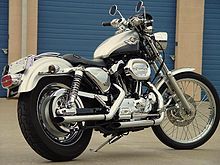
Introduced in 1957, the Sportster family were conceived as racing motorcycles, and were popular on dirt and flat-track race courses through the 1960s and 1970s. Smaller and lighter than the other Harley models, contemporary Sportsters make use of 883 cc or 1,200 cc Evolution engines and, though often modified, remain similar in appearance to their racing ancestors.[21]
Up until the 2003 model year, the engine on the Sportster was rigidly mounted to the frame. The 2004 Sportster received a new frame accommodating a rubber-mounted engine. Although this made the bike heavier and reduced the available lean angle, it reduced the amount of vibration transmitted to the frame and the rider.[22] The rubber mounted engine provides a significantly smoother ride for rider and passenger, allowing longer trips.
In the 2007 model year, Harley-Davidson celebrated the 50th anniversary of the Sportster and produced a limited edition called the XL50, of which only 2000 were made for sale worldwide. Each motorcycle was individually numbered and came in one of two colors, Mirage Pearl Orange or Vivid Black. Also in 2007, electronic fuel injection was introduced to the Sportster family, and the Nightster model was introduced in mid-year. In 2009, Harley-Davidson added the Iron 883 to the Sportster line, the newest in the Dark Custom series.
In the 2008 model year, Harley-Davidson released the XR1200 Sportster in Europe, Africa, and the Middle East. The XR1200 had an Evolution engine tuned to produce 91 bhp (68 kW), four-piston dual front disc brakes, and an aluminum swing arm. Motorcyclist featured the XR1200 on the cover of its July 2008 issue and was generally positive about it in their "First Ride" story, in which Harley-Davidson was repeatedly asked to sell it in the United States.[23] One possible reason for the delayed availability in the United States was the fact that Harley-Davidson had to obtain the "XR1200" naming rights from Storz Performance, a Harley customizing shop in Ventura, Calif.[24] The XR1200 was released in the United States in 2009 in a special color scheme including Mirage Orange highlighting its dirt-tracker heritage. The first 750 XR1200 models in 2009 were pre-ordered and came with a number 1 tag for the front of the bike, autographed by Kenny Coolbeth and Scott Parker and a thank you/welcome letter from the company, signed by Bill Davidson.[citation needed]
VRSC[edit]

Introduced in 2001, the VRSC family bears little resemblance to Harley's more traditional lineup. Competing against Japanese and American muscle bikes and seeking to expand its market appeal, the "V-Rod" makes use of an engine developed jointly with Porsche that, for the first time in Harley history, incorporates overhead cams and liquid cooling. The V-Rod is visually distinctive, easily identified by the 60-degree V-Twin engine, the radiator and the hydroformed frame members that support the round-topped air cleaner cover. Based on the VR-1000 racing motorcycle, it continues to be a platform around which Harley-Davidson builds drag-racing competition machines.
In 2008, Harley added the anti-lock braking system as a factory installed option on all VRSC models.[17] Harley also increased the displacement of the stock engine from 1,130 to 1,250 cc (69 to 76 cu in), which had only previously been available from Screamin' Eagle, and added a slipper clutch as standard equipment.
VRSC Models Include:
VRSCA: V-Rod (2002–2006), VRSCAW: V-Rod (2007–2010), VRSCB: V-Rod (2004–2005), VRSCD: Night Rod (2006–2008), VRSCDX: Night Rod Special (2007–2010), VRSCSE: Screamin' Eagle CVO V-Rod (2005), VRSCSE2: Screamin' Eagle CVO V-Rod (2006), VRSCR: Street Rod (2006–2007), VRSCX: Screamin' Eagle Tribute V-Rod (2007), VRSCF: V-Rod Muscle (2009–2010).
VRXSE[edit]
The VRXSE V-Rod Destroyer is Harley-Davidson's production drag racing motorcycle, constructed to run the quarter mile in under ten seconds. It is based on the same revolution engine that powers the VRSC line, but the VRXSE uses the Sceamin' Eagle 1,300 cc "stroked" incarnation, featuring a 75 mm crankshaft, 105 mm Pistons, and 58 mm throttle bodies.
The V-Rod Destroyer is not a street legal motorcycle.
Custom Vehicle Operations[edit]
Custom Vehicle Operations (CVO) is a team within Harley-Davidson that produces limited-edition customizations of Harley's stock models. Every year since 1999, the team has selected two to five of the company's base models and added higher-displacement engines, performance upgrades, special-edition paint jobs, more chromed or accented components, audio system upgrades, and electronic accessories to create high-dollar, premium-quality customizations for the factory custom market. The models most commonly upgraded in such a fashion are the Ultra Classic Electra Glide, which has been selected for CVO treatment every year from 2006 to the present, and the Road King, which was selected in 2002, 2003, 2007, and 2008. The Dyna, Softail, and VRSC families have also been selected for CVO customization.
Environmental record[edit]
The Environmental Protection Agency conducted emissions-certification and representative emissions test in Ann Arbor, Michigan, in 2005. Subsequently, Harley-Davidson produced an "environmental warranty." The warranty ensures each owner that the vehicle is designed and built free of any defects in materials and workmanship that would cause the vehicle to not meet EPA standards.[25] In 2005, the EPA and the Pennsylvania Department of Environmental Protection (PADEP) confirmed Harley-Davidson to be the first corporation to voluntarily enroll in the One Clean-Up Program. This program is designed for the clean-up of the affected soil and groundwater at the former York Naval Ordnance Plant. The program is backed by the state and local government along with participating organizations and corporations.[26]
Paul Gotthold, Director of Operations for the EPA, congratulated the motor company:
| “ | "Harley-Davidson has taken their environmental responsibilities very seriously and has already made substantial progress in the investigation and cleanup of past contamination. Proof of Harley's efforts can be found in the recent EPA determination that designates the Harley property as 'under control' for cleanup purposes. This determination means that there are no serious contamination problems at the facility. Under the new One Cleanup Program, Harley, EPA, and PADEP will expedite the completion of the property investigation and reach a final solution that will permanently protect human health and the environment."[26] | ” |
Harley-Davidson has also purchased most of Castalloy, which is a South Australian producer of cast motorcycle wheels and hubs. The South Australian government has set forth "protection to the purchaser (Harley-Davidson) against environmental risks."[27]
Harley-Davidson culture[edit]
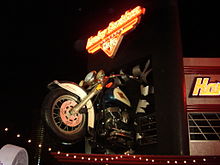
According to a recent Harley-Davidson study, in 1987 half of all Harley riders were under age 35.[28] Now, only 15% of Harley buyers are under 35,[28] and as of 2005, the median age had risen to 46.7.[29][30][31][32]
The income of the average Harley-Davidson rider has risen, as well. In 1987, the median household income of a Harley-Davidson rider was $38,000. By 1997, the median household income for those riders had more than doubled, to $83,000.[28][clarification needed]
Harley-Davidson attracts a loyal brand community,[33] with licensing of the Harley-Davidson logo accounting for almost 5% of the company's net revenue ($41 million in 2004).[34] Harley-Davidson supplies many American police forces with their motorcycle fleets.[35]
Harley-Davidson motorcycles has long been associated with the sub-cultures of the biker, motorcycle clubs, and Outlaw motorcycle clubs, or one percenters
Origin of "Hog" nickname[edit]
Beginning in 1920, a team of farm boys, including Ray Weishaar, who became known as the "hog boys," consistently won races. The group had a live hog as their mascot. Following a win, they would put the hog on their Harley and take a victory lap.[36] In 1983, the Motor Company formed a club for owners of its product taking advantage of the long-standing nickname by turning "hog" into the acronym HOG., for Harley Owners Group. Harley-Davidson attempted to trademark "hog", but lost a case against an independent Harley-Davidson specialist, The Hog Farm of West Seneca, NY,[37] in 1999 when the appellate panel ruled that "hog" had become a generic term for large motorcycles and was therefore unprotectable as a trademark.[38]
On August 15, 2006, Harley-Davidson Inc. had its NYSE ticker symbol changed from HDI to HOG.[39]
WHQG, a mainstream rock radio station which serves the Milwaukee metropolitan area, uses the moniker in their official callsign (102.9 The Hog) as a tribute to their home town motorcycle manufacturer, as well as its fans and riders.[citation needed]
Harley Owners Group[edit]
Harley-Davidson established the Harley Owners Group (HOG) in 1983 to build on the strong loyalty and fraternity of Harley-Davidson enthusiasts as a means to promote not just a consumer product, but a lifestyle. The HOG has also served to open new revenue streams for the company, with the production of tie-in merchandise offered to club members, numbering over one million strong. Other motorcycle brands,[40] and other and consumer brands outside motorcycling, have tried to imitate the Harley-Davidson's success in this endeavor by creating factory-sponsored community marketing clubs of their own.[41] HOG members typically spend 30% more than other Harley owners, on such items as clothing and Harley-Davidson-sponsored events.[42]
In 1991, HOG went international, with the first official European HOG Rally in Cheltenham, England.[43] Today, more than one million members and more than 1400 chapters worldwide make HOG the largest factory-sponsored motorcycle organization in the world.[44]
HOG benefits include organized group rides, exclusive products and product discounts, insurance premium discounts, and the Hog Tales newsletter. A one year full membership is included with the purchase of a new, unregistered Harley-Davidson.[45]
In 2008, HOG celebrated its 25th anniversary in conjunction with the Harley 105th in Milwaukee Wisconsin.
Factory tours and museum[edit]
Harley-Davidson offers factory tours at four of its manufacturing sites, and the Harley-Davidson Museum, which opened in 2008, exhibits Harley-Davidson's history, culture, and vehicles, including the motor company's corporate archives.[46][47]
- York, Pennsylvania – Vehicle Operations: Manufacturing site for Touring class, Softail, and custom vehicles.
- Tomahawk, Wisconsin – Tomahawk Operations: Facility that makes sidecars, saddlebags, windshields, and more.
- Kansas City, Missouri – Vehicle and Powertrain Operations: Manufacturing site of Sportster, VRSC, and other vehicles.
- Menomonee Falls, Wisconsin – Pilgrim Road Powertrain Operations plant, two types of tours.
- Milwaukee, Wisconsin – Harley-Davidson Museum: Archive; exhibits of people, products, culture and history; restaurant & café; and museum store.
Due to the consolidation of operations, the Capitol Drive Tour Center in Wauwatosa, Wisconsin was closed in 2009.
Anniversary celebrations[edit]
Beginning with Harley-Davidson's 90th anniversary in 1993, Harley-Davidson has had celebratory rides to Milwaukee called the "Ride Home".[48] This new tradition has continued every 5 years, and is referred to unofficially as "Harleyfest," in line with Milwaukee's other festivals (Summerfest, German fest, Festa Italiana, etc.). This event brings Harley riders from all around the world.[49][50] The 105th anniversary celebration was held on August 28–31, 2008,[51] and included events in Milwaukee, Waukesha, Racine, and Kenosha counties, in Southeast Wisconsin.
Video games and pinball machines[edit]

There were several games inspired by Harley-Davidson motorcycles. The first was Harley-Davidson: The Road to Sturgis, released for the Amiga in 1990. Several other Harley-Davidson games were released for the PC, PlayStation 2, and the Wii.
Two arcade games that were inspired by Harley-Davidson motorcycles were released by Sega: The first, released in December 1997, was Harley-Davidson & L.A. Riders, which featured five Harley-Davidson models: the 1990 FLSTF Fat Boy, 1948 FL Panhead, FXDWG Dyna Wide Glide, Sportster 1200 Sport, and the 1988 FXRP police motorcycle. A sequel, Harley-Davidson: King of the Road, was released in early 2009.
Two pinball games were also inspired by Harley-Davidson motorcycles. Both were named "Harley Davidson". One was made by Bally in 1991; it was the last Bally game to have alphanumeric score displays. The other was made by Stern in 1999. The Stern pinball machine, which was re-released in 2002 and again in 2005, included scale models of the 1999 FLSTF Fat Boy, the 2000 FLSTF Fat Boy, and the 2001 FLSTS Heritage Springer.
Labor Hall of Fame[edit]
Because William S. Harley, Arthur Davidson, William A. Davidson and Walter Davidson, Sr. used and believed in H-D products and relied on the dedication of its employees to produce quality motorcycles, the four men were inducted into the Labor Hall of Fame.[52]
See also[edit]
Notes[edit]
- ^ Herbert Wagner, 2003. At the Creation: Myth, Reality, and the Origin of the Harley-Davidson Motorcycle, 1901–1909 (Madison: Wisconsin Historical Society Press), pp.22–28, 42–44.
- ^ Wagner, 2003. pp.45–62.
- ^ "Harley-Davidson, Toyota and Porsche Brands Lose Value". Pravda.ru. September 21, 2009. Retrieved October 1, 2009.
- ^ Garrett, Jerry (September 14, 2010). "Harley-Davidsons to Remain Wisconsin-Made". The New York Times.
- ^ Cite error: The named reference
wfwvmgwas invoked but never defined (see the help page). - ^ "Howstuffworks "The Harley Sound and Mystique"". auto.howstuffworks.com. Retrieved April 27, 2008.
- ^ "Harley-Davidson – Timeline 1990's". www.harley-davidson.com. Retrieved April 27, 2008.
- ^ "Harley-Davidson Motorcycle Fuel Injection Explained". www.nightrider.com. Retrieved April 27, 2008.
- ^ "The Trademark Registrability of the Harley-Davidson Roar: A Multimedia Analysis". www.bc.edu. Retrieved April 27, 2008.
- ^ O'Dell, John (June 21, 2000). "Harley-Davidson Quits Trying to Hog Sound". Los Angeles Times. Retrieved September 19, 2010.
- ^ Popely, Rick (June 15, 2003). "Harley-Davidson Describes Motorcycles' Characteristic 'Potato' Sound" (Document). Knight Ridder Tribune Business News. p. 1.
- ^ "First Ride: 2002 Harley-Davidson VRSCA V-Rod". motorcycle.com. Retrieved December 14, 2007.
- ^ "Harley-davidson v-rod – jeckyl or hyde!". Motorbikes Today. Retrieved December 14, 2007.
- ^ "Harley-Davidson Company History Timeline 2000". Harley-Davidson Motor Company Website. Retrieved December 14, 2007.
- ^ "Motor Company History". North Texas Harley Owners Group. Retrieved December 14, 2007.
- ^ Newbern, Michael (August 8, 2006). "First Ride: 2007 FLHX".
- ^ a b "ABS OPTION ON ALL HARLEY-DAVIDSON TOURING AND VRSC MODELS" (Press release). Harley-Davidson. July 9, 2007. Retrieved September 26, 2007.
- ^ 2009 Harley-Davidson 2009 model line. Harley-davidson.com. Retrieved on July 7, 2011.
- ^ Edge, Dirck (August 4, 2008). "2009 Harley-Davidson Touring Models and V-Rod Muscle – MD First Rides".
- ^ 2009 Harley-Davidson Tri-Glide Ultra Classic. Harley-davidson.com. Retrieved on July 7, 2011.
- ^ Richard Backus (March–April 2010). "1972–1985 Harley-Davidson Sportster 1000". Motorcycle Classics. Retrieved May 21, 2010.
- ^ ''Motorcycle Cruiser'' First Ride: 2004 Harley-Davidson Sportster Motorcycles. Motorcyclecruiser.com (2011-02-28). Retrieved on July 7, 2011.
- ^ Cathcart, Alan (July 2008). "First Ride: 2008 Harley-Davidson XR1200 – Get Sporty!". Motorcyclist. Source Interlink Magazines: 49–53.
{{cite journal}}: Cite has empty unknown parameters:|lay-source=and|lay-date=(help)CS1 maint: date and year (link) - ^ Richard Backus (September–October 2009). "2009 Harley-Davidson XR1200". Motorcycle Classics. Retrieved August 20, 2009.
- ^ Representative Emissions Test March 9, 2005 retrieved May 14, 2008
- ^ a b Former York Naval Ordnance Plant 2005. Retrieved May 14, 2008
- ^ Harley-Davidson's purchase of Castalloy assets 2008. Retrieved May 14, 2008
- ^ a b c Harley Just Keeps On Cruisin'. Business Week (2006-11-06). Retrieved on July 7, 2011. Cite error: The named reference "age35" was defined multiple times with different content (see the help page).
- ^ Harley-Davidson Riders Settle Into Middle Age, Times Community Newspapers[dead link]
- ^ Bumpy ride for Harley as competitors improve, customers age, SavannaNow
- ^ Packs of Easy Riders Attract More Golden Agers, Coastal Senior. Coastalsenior.com. Retrieved on July 7, 2011.
- ^ Chart, source: Harley-Davidson
- ^ Richard Pierson and Alexander Bozmoski (March 2003). "Harley-Davidson's 100th anniversary – the sound of a legend". Sound and Vibration. Retrieved December 13, 2007.
{{cite news}}: CS1 maint: date and year (link) CS1 maint: url-status (link) [dead link] - ^ Standard & Poor's (December 2005). The Standard & Poor's 500 Guide. McGraw-Hill Professional. ISBN 0-07-146823-4.
- ^ "On Patrol" (PDF). 2005 Harley-Davidson Police Motorcycles. Archived from the original (PDF) on September 27, 2007. Retrieved June 18, 2007.
- ^ Harley-Davidson – History
- ^ "Decision at the U.S. Second Circuit Federal Court of Appeals N.Y.C.: Corporate Harley Davidson LOST the Hog Trademark". The-hog-farm. January 15, 1999. Retrieved January 5, 2009.
- ^ "Motorcycle manufacturer has no trademark right in 'hog'". News Media Update. Retrieved December 13, 2007.
- ^ "Harley-Davidson: High on the Hog". BusinessWeek. Retrieved December 13, 2007.
- ^ Jelassi, Tawfik; Leenen, Stefanie (June 27–29, 2001). EMBARKING ON E-BUSINESS AT DUCATI MOTORCYCLES (ITALY) [CASE STUDY] (PDF). Bled, Slovenia: Global Co-Operation in the New Millennium The 9th European Conference on Information Systems.
- ^ Denove, Chris; Power, IV, James D. (2007). Satisfaction: How Every Great Company Listens to the Voice of the Customer. Portfolio. p. 195. ISBN 1-59184-164-X, 9781591841647.
{{cite book}}: Check|isbn=value: invalid character (help) - ^ Clifton, Rita; Simmons, John; Ahmad, Sameena (2004). Brands and branding; The economist series (2nd ed.). Bloomberg Press. ISBN 1-57660-147-1, 9781576601471.
{{cite book}}: Check|isbn=value: invalid character (help) - ^ "H.O.G. History". Windsor Harley Owners Group. Retrieved December 13, 2007.
- ^ "Harley Owners Group Members Ready To Rendezvous In Adirondacks". Motorcyclist. Retrieved December 13, 2007.
- ^ "H.O.G. Membership". Harley-Davidson Motor Company. Retrieved December 13, 2007.
- ^ Harley-Davidson USA: ''The Great American Factory Tour''. Harley-davidson.com. Retrieved on July 7, 2011.
- ^ Harley-Davidson USA: ''Museum Customized by Harley-Davidson''. Harley-davidson.com. Retrieved on July 7, 2011.
- ^ Ride Home. Harley-davidson.com. Retrieved on July 7, 2011.
- ^ Harleyfest Example. Harley-davidson.com (2008-08-28). Retrieved on July 7, 2011.
- ^ "Milwaukee Area Homes Rented To Harley Fest Bikers". WITI. August 6, 2008.
- ^ The 105th. Harley-davidson.com. Retrieved on July 7, 2011.
- ^ U.S. Department of Labor – Labor Hall of Fame – Harley Davidson. Dol.gov. Retrieved on July 7, 2011.
References[edit]
- Bach, Sharon, & Ostermann, Ken, eds. 1993. The Legend Begins: Harley-Davidson Motorcycles, 1903–1969 (Harley-Davidson, Inc.)
- Mitchel, D. (1997). Harley-Davidson Chronicle – An American Original. Publications International Limited. ISBN 0-7853-2514-X.
- Wagner, Herbert, 2003. At the Creation: Myth, Reality, and the Origin of the Harley-Davidson Motorcycle, 1901–1909 (Wisconsin Historical Society Press)
- Wilson, H. "The Encyclopedia of the Motorcycle" Dorling-Kindersley Limited, 1995 ISBN 0-7513-0206-6
External links[edit]


